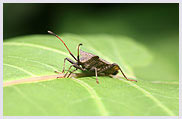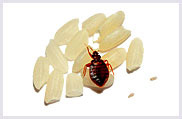
Bed Bugs Causes & Solutions

 Don’t Let Bed Bugs Get the Best of You
Don’t Let Bed Bugs Get the Best of You
Bed Bug Revival
After over 50 years without bed bugs, infestations are increasingly common in the U.S. Bed bugs have taken up residence in schools, shelters, houses, apartments, motels, health care facilities, buses, offices, movie theatres—basically any structure that people use.
The common bed bug, Crimex lectularis, is a one-quarter-inch-long brown insect with a flattened body. It feeds only on the blood of warm-blooded animals, preferably humans. These little bugs are very resilient; the young can survive for months and the adults for a year or more without feeding. Bed bugs can’t fly, but that doesn’t stop them from moving quickly over floors, walls, ceilings, and other surfaces. Females lay one or two eggs per day in secluded places, totaling hundreds of eggs in a lifetime.
During the day bed bugs hide in tiny crevices close to the places where people sleep. Mattresses, box springs, headboards, and bed frames are perfect hiding places for bed bugs. Infestations typically start near beds, but quickly spread throughout the room and to adjacent rooms.
 Biting Behaviour
Biting Behaviour
A bed bug uses its elongated beak to pierce the skin and withdraw blood from a person. It takes about five to ten minutes for it to eat its fill, after which it drops and goes back into hiding. Bed bugs may bite any exposed part of the body. Some people have no reaction to the bite, while others develop itchy red welts and swelling either immediately or up to a week later. Bed bugs don’t transmit diseases to people, but they can definitely interfere with sleep and make life miserable.
 Is it a Bed Bug?
Is it a Bed Bug?
Before you take steps to eliminate or control bed bugs, make sure you actually have bed bugs. If people wake up with bites you may suspect bed bugs, but other pests can bite in the night. Look in bedding, on curtains, behind loose wallpaper and molding, and in furniture for the live insects and for brown or reddish fecal spots. Compare the insects you find with pictures of bed bugs, or ask you local health department for help with identification.
Once you know for sure that you have bed bugs, you can make a plan to eliminate, or at least control, them. You may decide to use chemicals to control the infestation, but there’s a lot you can do without pesticides. The next section is full of practical ways to deal with bed bugs.
Bye-Bye Bed Bugs
Following are suggestions to ridding your home of bed bugs. Many people have used these methods with success.
- Use mattress protectors to keep bugs from biting you in bed. A complete surround mattress cover that zips around and encases the entire mattress keeps bed bugs from getting in or out. They protect new mattresses from bugs and contain bed bugs that are already in older mattresses. Because they can live a long time without food the bed bugs may take several months to die, but they are imprisoned in the mattress protector so they can’t bite you.
- Zippered mattress protectors come in vinyl or cotton. A cotton mattress cover with a waterproof layer is a comfortable, breathable choice. You can also enclose pillows in pillow protectors. Bed bugs and their eggs can make their way through tiny zipper holes, so it’s important to put permanent tape over all the zippers.
- Reduce clutter in order to limit hiding places for bed bugs. Thoroughly clean the infested rooms and adjacent rooms. Use a powerful vacuum cleaner to pull bugs from cracks and crevices. Remove drawers and turn over furniture to find more hiding places.
- To keep bed bugs from getting onto beds, pull beds away from walls, keep sheets and blankets off the floor, and put the legs of beds in cups of mineral oil. You can use a regular cup or bowl or special a special cup within a cup designed specifically as a bed bug barrier. Caulk wall openings and cracks, including holes where pipes and wires go through walls.
- The best way to kill all the life stages of bed bugs in bedding and clothing is to put them in a clothes dryer for 10 to 20 minutes at medium to high heat. Manufacturers have developed portable heating units for items that can’t go in a dryer, like books, shoes, and toys. Some people have reported success with loosely bagging items in plastic and putting them in a hot, sunny place—such as the inside of a car—for a day or more.
- You may have to throw out some heavily infested items, particularly beds, sofas, and other upholstered furniture, especially if they have holes or tears. To help prevent spreading the bugs, wrap the pieces in plastic before you dispose of them. To discourage people from taking the furniture home, make it undesirable by damaging it, or put a warning note on it.
Moving away
If you are frustrated by trying to rid your home of bed bugs or tired of living with the pests, you may be tempted to move and start over. Be aware, however, that unless you are extremely careful you are likely to bring the bed bugs with you. You will have to make sure all your belongings are free from bed bugs before you move them into your new home, or throw out what you can’t completely clean.
Don’t panic
Remember, while they are annoying, irritating, and maybe embarrassing, bed bugs rarely pose any serious health risks. If you make a plan and follow through on the measures described above, you can get rid of them or at least keep them at a very manageable level.



 Copyright © 2025 |
Copyright © 2025 |